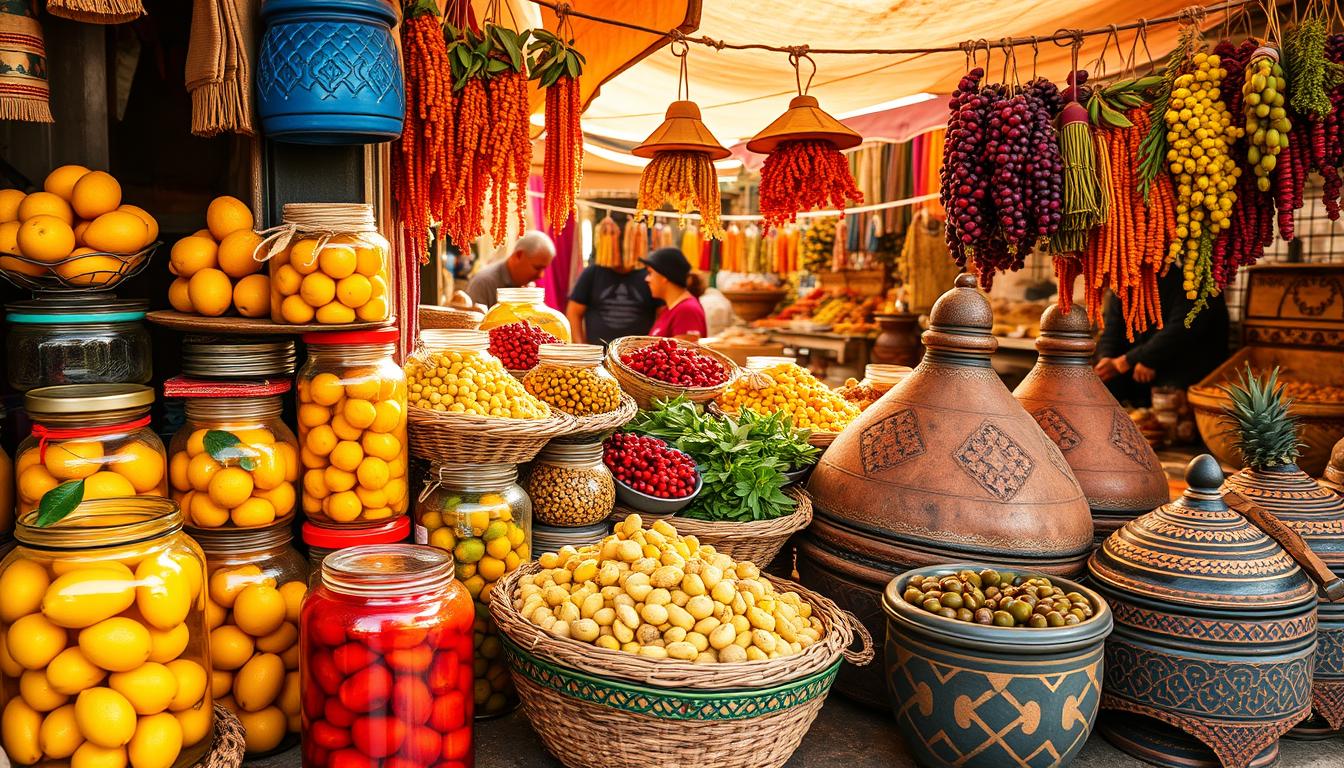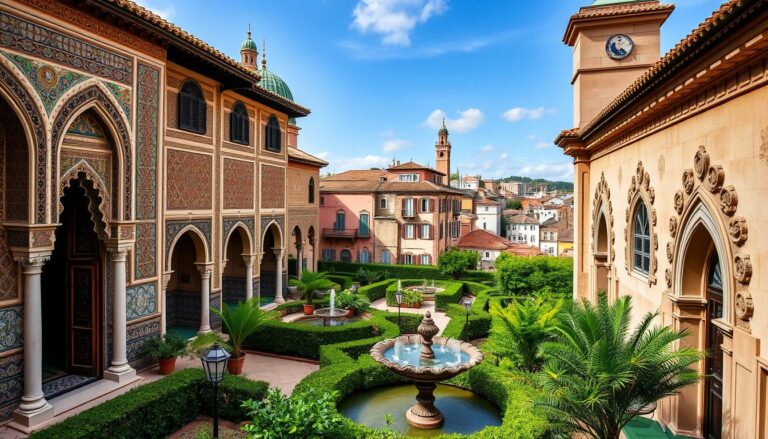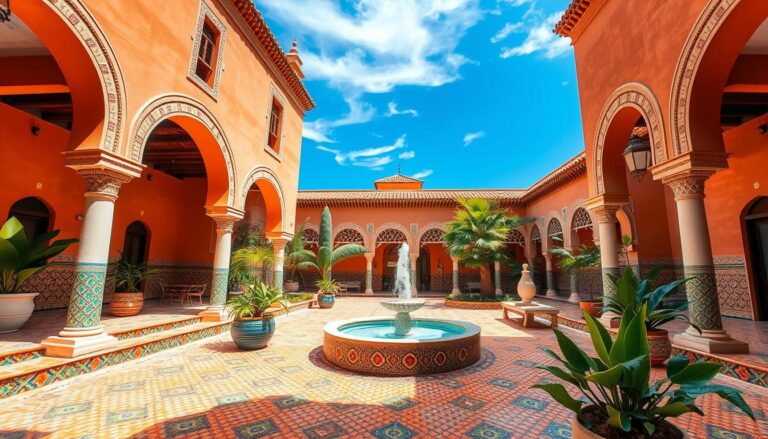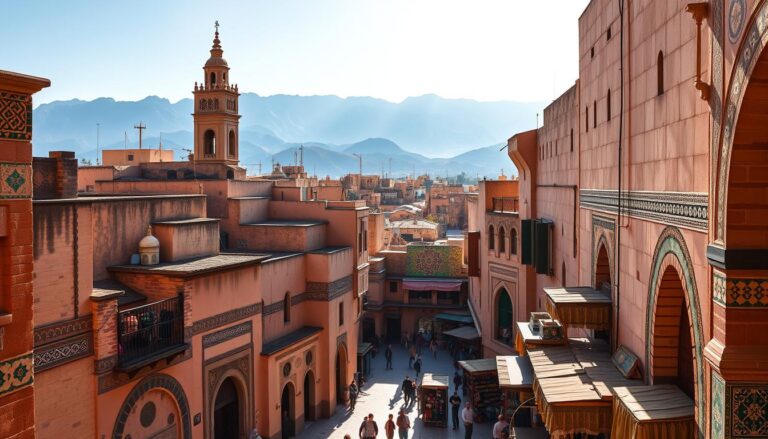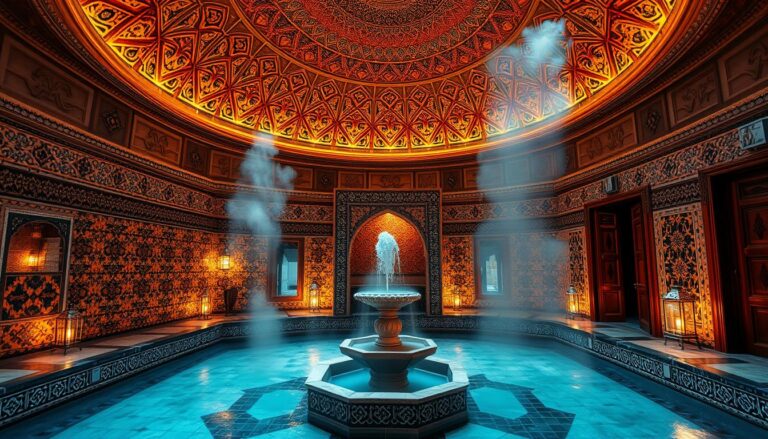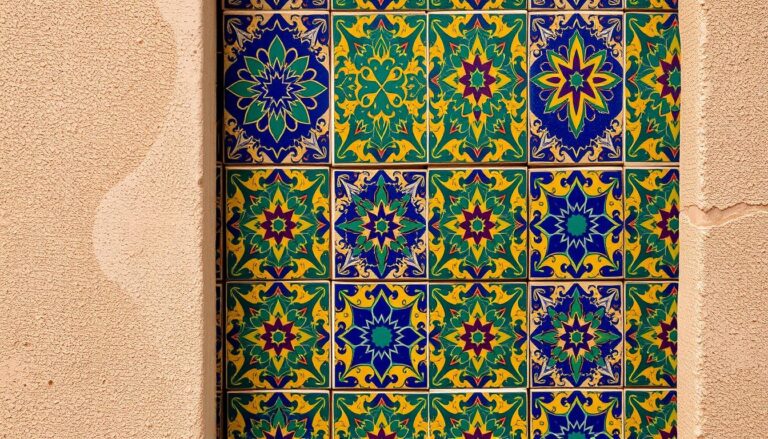Ever wondered how Moroccan food keeps its vibrant flavors and rich aromas? It’s thanks to ancient preservation methods. These techniques, like salt-packed lemons for tagines and fermented condiments, are more than just keeping food fresh. They are a culinary art that has shaped Moroccan food culture.
Key Takeaways
- Moroccan preservation techniques include pickling, drying, salting, smoking, and fermentation.
- These ancient methods not only extend the shelf life of food but also enhance the unique flavors and nutritional value of Moroccan cuisine.
- Preserved lemons are a Moroccan specialty, made by salt-packing fresh lemons in their own juice.
- Moroccan preservation methods have been passed down for generations and are an integral part of the country’s culinary heritage.
- Fermentation, curing, and smoking are other popular preservation techniques used in traditional Moroccan cooking.
Introduction to Moroccan Preservation Techniques
Moroccan cuisine is famous for its rich culture and diverse tastes. This is thanks to the country’s long tradition of food preservation. Moroccans have perfected various preservation methods to keep their ingredients fresh and flavorful.
These methods not only make food last longer but also keep its unique taste and nutrients. This is key to Moroccan cuisine’s enduring appeal.
Overview of Traditional Food Preservation Methods
Moroccan food preservation includes pickling, drying, salting, and fermentation. These methods have been passed down through generations. They allow Moroccan families to enjoy their culinary heritage.
For example, sun-drying meat creates a gueddid, a dried meat that lasts months. It’s used in many winter dishes.
Importance of Preserving Food in Moroccan Culture
Food preservation is crucial in Moroccan culture. It ensures food security and shares traditional recipes and cooking methods. Morocco’s diverse climate and farming practices made these preservation techniques essential.
Ingredients like smen (fermented butter) and ras el hanout spice blend are vital. They are the heart of Morocco’s delicious and varied cuisine.
“The preservation of food is not just a practical necessity in Morocco, but a cherished tradition that connects us to our rich cultural heritage.”
Lemon Preservation: A Moroccan Specialty
In Morocco, preserving lemons is a beloved tradition. Moroccan preserved lemons, or “l’hamed” or “l’hamd,” add a special flavor to famous dishes.
The Process of Making Preserved Lemons
The process starts with salt-packing fresh lemons in their juice. They cure for at least a month. This makes the lemons less sour and adds a salty taste.
These preserved lemons are key in Moroccan tagines, stews, and salads. They give dishes a unique flavor.
Varieties of Lemons Used in Moroccan Lemon Preservation
The best lemons for lemon preservation are doqq and boussera. But Eureka and Meyer lemons work well too. These lemons have strong flavors and aromas.
They are perfect for salt-packing. This creates a mix of salty, sour, and sweet tastes.
“Preserving lemons is an art form in Moroccan cuisine, where they are used to add depth and complexity to a wide range of dishes.”
Moroccan preserved lemons are used in many dishes. They add depth and brightness. They show Morocco’s skill in food preservation.
Salt-Packing: An Ancient Preservation Method
In Morocco, salt-packing is a key food preservation technique. It involves packing food like lemons, meats, or olives in coarse kosher salt. This removes water, microbes, and bacteria. It’s a method used for centuries in Moroccan cooking.
Using coarse salt without additives is key for salt-packing. It not only keeps food fresh longer but also adds flavor. For example, preserved lemons can last up to 6 months in the fridge. Each serving has about 8 calories and 51% of the daily sodium.
Making preserved lemons takes about 15 minutes. You need 6-8 lemons and 4-5 tablespoons of salt. The lemons need to sit in a cool, dry place for at least a week before refrigeration.
“Salt-packing is a testament to the ingenuity and resilience of Moroccan culinary traditions, preserving the flavors and nutritional value of food for generations.”
Salt-packing is a vital part of Moroccan culture. It shows the country’s deep culinary heritage. This method is still loved by chefs and home cooks today.
Moroccan Preservation techniques
Moroccan cuisine is famous for its many preservation methods. These methods mix flavors and keep food fresh for longer. Pickling and drying/curing are key to keeping the region’s food and meat fresh.
Pickling: A Popular Technique for Preserving Vegetables
Pickling is a long-standing tradition in Moroccan cooking. It’s used to keep vegetables like carrots, cucumbers, and peppers fresh. By soaking them in vinegar or acidic solutions, pickling adds a tangy taste and keeps them good for longer.
Drying and Curing: Preserving Meats and Fruits
Drying and curing are big in Moroccan cooking for meats, fish, and fruits. These methods remove moisture, stopping bacteria and keeping food fresh. Dried and cured foods add rich flavors to Moroccan dishes like stews and tagines.
The variety of pickling, drying, and curing in Moroccan cooking shows the area’s culinary creativity. It also shows how important vegetable preservation and meat preservation are in keeping this cuisine’s rich flavors alive.
“In Morocco, salted lemons are used in 95% of dishes to add a unique flavor.”
Fermentation: A Healthy Way to Preserve Food
In Moroccan cuisine, fermentation is a key way to keep food fresh for longer. It also brings health benefits. Foods like harissa, smen, and pickled veggies are loved in Moroccan cooking.
Traditional Fermented Foods in Moroccan Cuisine
Fermentation uses good bacteria to keep food fresh and make it healthier. Moroccan foods are known for their special tastes. They are used as seasonings and main ingredients in many dishes.
- Fermented lemons can last 6-12 months when properly preserved, making them a long-lasting food preservation method.
- The fermentation process takes at least a month at room temperature to achieve the desired results, and the preserved lemons can be stored for over a year in the refrigerator.
- Moroccan and North African cuisine commonly incorporate fermented lemons in dishes like tagines, contributing to their popularity in these regions.
Fermented Moroccan foods taste great and are good for your gut. They are full of beneficial bacteria. This shows how smart and health-focused Moroccan cooking has always been.
“Fermentation is a healthy way to preserve food, and it’s been a part of Moroccan cuisine for centuries. The unique flavors and nutritional benefits of fermented foods make them an integral part of our culinary tradition.”
Smoking and Curing: Preserving Meats
In Morocco, smoking and curing are key to keeping meats fresh. These methods not only make the meat last longer but also add special flavors. These flavors are key to Morocco’s famous dishes.
Smoking has been around for thousands of years. It involves letting the meat soak in smoke from wood or charcoal. This gives the meat a unique taste and helps preserve it. Moroccan smokehouses usually heat up to 109 to 160 °F (43 to 71 °C) for smoking. The time needed varies, from a few hours to days, based on the meat type and moisture.
Curing uses salt, nitrites, and other preservatives to keep moisture out and stop bacteria growth. This method has been crucial in Morocco for centuries. It keeps the meat fresh and flavorful for dishes like tagines, braises, and sausages.
By combining smoking and curing, Moroccan chefs have developed a wide range of meat preservation techniques. These methods add unique flavors to Moroccan food. From the smoky taste of cured meats to the tender, flavorful results of smoking, these practices are loved by many.
“Smoking and curing have been essential to Moroccan cuisine for generations, preserving the rich, complex flavors that define the country’s culinary heritage.”
These preservation methods are not just for meats. Moroccan chefs also use them for fish, cheese, nuts, and even hard-boiled eggs. This focus on preserving ingredients has been a big part of Moroccan cuisine for centuries. It ensures that the best flavors and textures are enjoyed all year.
Salting: A Simple Yet Effective Preservation Method
In Morocco, salting is a key way to keep food fresh. It involves using salt to remove moisture and stop harmful bacteria from growing. This method is used to preserve seafood and olives, which are very important in Moroccan cooking.
Salting Techniques for Preserving Fish and Olives
Salting makes fish and olives taste bold and savory. It’s a simple yet effective way to keep food fresh for a long time. Salt stops bacteria from growing, making the food safe and lasting longer.
To salt fish and olives, layers of salt are used, sometimes with spices and herbs. This process removes moisture, leaving behind a flavorful product. It’s a way to keep the taste of Moroccan dishes alive and to honor the country’s food traditions.
“Salting has been a time-honored tradition in Moroccan cuisine, preserving the distinct flavors of the region’s seafood and olives for generations.”
Salting is used in many Moroccan dishes, like tagines and salads. It adds a unique flavor to the food. Moroccan cooks have perfected salting, making these ingredients last longer and more versatile. This shows their skill and creativity in preserving food.
Conclusion
Moroccan preservation techniques have been around for centuries. They keep the flavors and nutrients of Moroccan food alive. Methods like pickling, drying, smoking, and fermenting have been passed down through generations.
These techniques ensure the food stays true to its roots. By understanding these methods, we can appreciate the rich culture and unique dishes of Moroccan cuisine.
In the North of Morocco, people live in isolated homes or small groups. These homes are found in green areas watered by rivers. In the South, where it’s dry and water is scarce, people cluster in valleys and oases.
Kasbahs, which are fortified homes for one family, and ksour, planned cities with defenses, are also part of Moroccan culture. These buildings show the importance of safety and community in Moroccan architecture.
Exploring Moroccan preservation techniques helps us value their culinary traditions. Preserving these methods keeps the flavors of Moroccan food alive. It also honors the cultural heritage that has shaped Morocco for centuries.
Source Links
- Next Time You Have Too Many Lemons, Try This Moroccan-Style Of Preservation – Chowhound
- How to Easily Make Moroccan Preserved Lemons at Home
- Moroccan Cured and Dried Meat – Gueddid
- Moroccan Best Cooking Techniques and 10 Tips: Mastering the Art of Flavorful Dishes – Moroccan Paradise
- Raising the awareness of fishing professionals about the conservation of species caught incidentally in the Moroccan Mediterranean Sea – Discover Conservation
- How to Preserve Lemons, for Moroccan Flavor
- How to Make Preserved Lemons (step-by-step) | The Mediterranean Dish
- How to Make Preserved Lemons
- Guide to Food Preservation Methods – Araven
- Preserved Lemons Are a Magical Ingredient That Can Elevate Your Cooking—These Are Our Favorite Ways to Use Them
- Moroccan preserved lemons, recipe | FalkTime
- Moroccan Cuisine — Quick Preserved Lemons
- Crop Preservation Methods in Morocco — High Atlas Foundation
- Fermented Lemons (Moroccan Preserved Lemons)
- Fermented Lemons {Preserved Spiced Lemons}
- 7 Ancient Methods of Food Preservation
- Smoking | Food Preservation & Methods | Britannica
- 6 high-quality ways to preserve your ingredients!
- How to Make Preserved Lemons – Taste of Maroc
- Moroccan Preserved Lemons
- How to Make Preserved Lemons – Non-Guilty Pleasures
- Preservation Strategies for Southern Morocco’s At-Risk Built Heritage
- How To Care For Moroccan Rugs: Maintenance Tips For Longevity
- Ethnobotanical survey of herbs used in the preservation of food products in Fez, Morocco – Journal of Ethnic Foods

The Editorial Team is a passionate group of Morocco enthusiasts dedicated to sharing the beauty, culture, and wonders of this captivating country. With diverse backgrounds and a deep love for travel, we strive to bring you engaging and informative content that inspires your Moroccan adventures. From uncovering hidden gems and sharing local insights to exploring mouthwatering cuisine and showcasing the vibrant lifestyle, our team is committed to providing you with valuable resources and exciting stories that enhance your exploration of Morocco. Join us on this journey as we celebrate the rich heritage and unforgettable experiences that make Morocco truly special.

